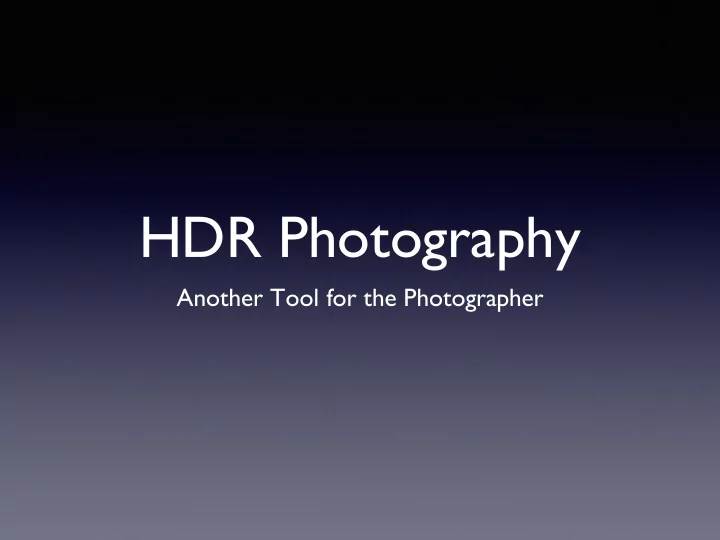

HDR Photography Another Tool for the Photographer
High Dynamic Range • What does it mean?
Ratio between the maximum & minimum measureable light intensities (white & black) • The human eye can see 24 stops, if allowed to adjust for the shadows. • (10-14 if pupils do not adjust.) • Printing paper and monitors see less than half that range. (Worse is the projector you are viewing now.) • So the goal for HDR photos is to compress that range
• Dynamic Range is simply the lightest to darkest exposures capable of registering with your camera. So HIGH Dynamic means more range. The problem is how do we effectively capture more range than our camera can record?
How Do I Create HDR? part 1 • Start with multiple exposures of the same image. (Keep the aperture the same, and change the exposure time.) • For SLRs, use AEB mode (auto bracketing). • For Point and Shoots, manually change the exposure each time. iPhone has HDR option • Use a tripod if possible.
How Do I create an HDR, part 2 • Once the images are loaded into the computer, use the newer special software. • “old choice” was layers in software • Film days was zone system and use of neutral density filters • free software (more limited) • commercial (time trials available)
Google HDR, and you get many choices: Aurora HDR (MAC only) Easy HDR HDR Darkroom Photoshop CS5-CC Elements Photomatix Nik HDR Effex, and now Lightroom 6
Pseudo HDR- What is it? • Created from one exposure, then use HDR software to tone map. This is not “real” HDR images, since no NEW dynamic range information was included in the creation.
What an HDR Image looks like
Tonemapping: the final step
Benefits • Really stop worrying about getting the right exposure • Exceed the digital camera’s range of capture • More detail and color
Problems: • Another layer of work for us photographers • Avoiding the “unnatural” or “grunge” photo • dealing with moving objects • contolling the image: halos around objects
The Real and Not So
Situations Where HDR Will Not Work • Sports photography • Closeup photography where objects move in the breezes • anytime you have movement of major elements • low contrast images- with no range, there is no benefit
Cameras are building HDR into the camera software: Will it be the best way to go?
Recommend
More recommend